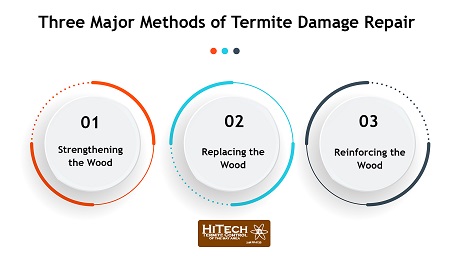Three Major Methods of Termite Damage Repair
 If you are a homeowner with a termite problem, then you will know that termite damage is no joke. These tiny terrors can turn your dream home into a snack to satisfy their insatiable appetites.
If you are a homeowner with a termite problem, then you will know that termite damage is no joke. These tiny terrors can turn your dream home into a snack to satisfy their insatiable appetites.
Termite damage repair paired with termite treatments is the only way to safeguard your house from these critters. In this blog, we will discuss the major methods of termite damage repair that can restore your house to its former glory.
Termite Damage Repair
Termite damage when left unrepaired can affect the structural integrity of the house. However, repairing the damage is useless when the termite infestation is not treated. You are just providing the termites with new and fresh wood to munch on. Hence, make sure that you first use termite control treatments before going ahead with termite damage repair.
The first step in termite damage repair involves analyzing the damage. Depending on the area of damage and its severity, you can choose the termite damage repair method.
Often, people tend to think that termite damage repair can be done by DIY methods but consulting a termite control professional is the wise thing to do. A termite control professional will perform a thorough check to make sure that the termite infestation is exterminated before starting the repair. He will also look for termite damage in places that you might have missed. After analyzing the severity of the damage, he will suggest a suitable termite damage repair method.
Also Read: Are Older Homes at a Higher Risk of Termite Infestation?
Here are the top 3 termite damage repair methods that a termite professional might suggest:
1. Strengthening the Wood
If the termite damage isn’t severe and is caught at the early stage, then you can simply strengthen the infested wood. This is mostly done when the wood has shallow fissures and surface damage.
Wood hardeners are applied to the wood and this material fills the fissures and cracks in the wood thus strengthening it. You can select the wood hardeners depending on the type of wood to be treated.
2. Replacing the Wood
This is one of the easiest methods of termite damage repair but it greatly depends on where the wood is located. If the infested wood is not located in a crucial space and can be removed without causing any damage to the structure, then you can simply replace the damaged wood with a new one.
Replacing the damaged wood is often faster and cheaper than the other methods. It also offers you the satisfaction of having fully taken out the damaged piece and making your house as good as new again.
3. Reinforcing the Wood
If replacing the wood compromises the integrity of the structure (for example, the infested wooden component could be a load-carrying beam or drywall), then you can reinforce the wood to provide additional support.
Not repairing the damage to these important components can accelerate the structural damage to the house. For example, if the joist that is providing support to the floor gets eaten hollow by the termites, your floor might start to sag fast. In that case, you can provide an additional beam as extra support for the joist. Make sure that you get a professional to do the work since it involves the structural safety of the house.
Also Read: How Does Liquid Termite Treatment Work?
Termite Preventive Control
Whether your house has been infested before or you have never experienced a termite infestation, preventive measures should be taken seriously. Termite infestation can get serious fast and is also very hard to get rid of. Hence, make sure that you employ termite prevention methods and also schedule regular termite inspections to avoid termites camping at your place.
HiTech Termite Control
Say goodbye to termite troubles with our expert team! We not only prevent these sneaky pests from invading your space but also specialize in seamless termite damage repair. Trust us to protect your home – because a termite-free zone is a happy home!
- Jan 10, 2024
